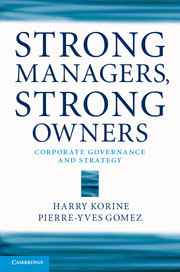Book contents
- Frontmatter
- Contents
- List of Figures
- List of Tables
- Foreword
- Acknowledgments
- Introduction
- Part I Changes in the identity of ownership and management
- Part II Changes in the form of ownership and organization
- 3 Change in legal structure
- 4 Change in organizational structure
- Concluding remarks
- Part III Changes in strategy
- Part IV Implications for corporate governance
- Notes
- Index
- References
Concluding remarks
from Part II - Changes in the form of ownership and organization
Published online by Cambridge University Press: 05 December 2013
- Frontmatter
- Contents
- List of Figures
- List of Tables
- Foreword
- Acknowledgments
- Introduction
- Part I Changes in the identity of ownership and management
- Part II Changes in the form of ownership and organization
- 3 Change in legal structure
- 4 Change in organizational structure
- Concluding remarks
- Part III Changes in strategy
- Part IV Implications for corporate governance
- Notes
- Index
- References
Summary
In Part I, we argued that changes in the identity of shareholders or in the identity of managers affect confidence in the future of the firm and competence in the execution of the firm’s strategy. In Part II, we have explained how changes in legal and organizational form constrain or enable shareholders and managers and, ultimately, affect strategy and governance. Building on the frameworks presented in Part I, we introduced a further core concept, the substitutability of shareholders and managers, as a means of understanding the mechanism by which changes in legal and organizational form shift the balance of power in the firm. Thus, how shareholders and managers act to shape strategy and governance depends not only on their values and methods, but also on how easy the legal and organizational form of the firm allows shareholders and managers, respectively, to be substituted. The more easily shareholders and/or managers are substituted, the weaker their commitment to a given strategy.
We now turn our attention to the question of how changes in strategy affect shareholders and managers. This may be seen as merely the other side of the coin, but, in reality, it has to be acknowledged that, just as changes in ownership and management can affect strategy, changes in strategy can lead to shifts in ownership, as shareholders who are not satisfied with the chosen strategy exit, and shifts in management, as managers who oppose the strategy leave the firm.
- Type
- Chapter
- Information
- Strong Managers, Strong OwnersCorporate Governance and Strategy, pp. 98 - 100Publisher: Cambridge University PressPrint publication year: 2013



